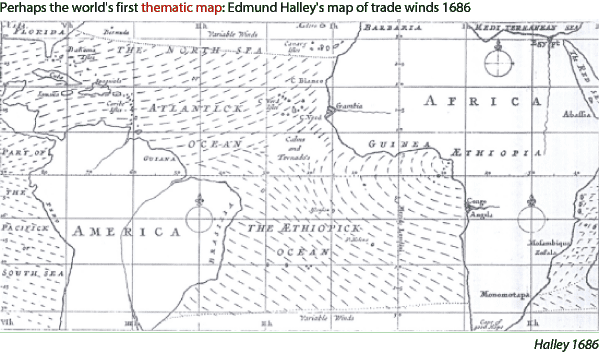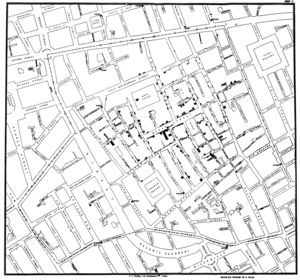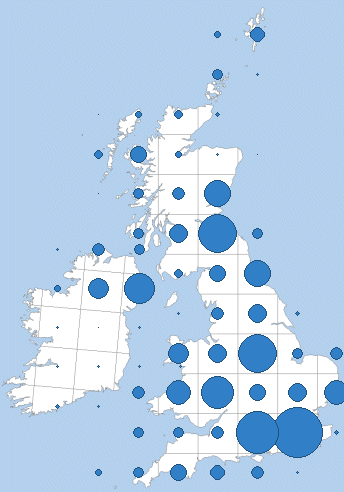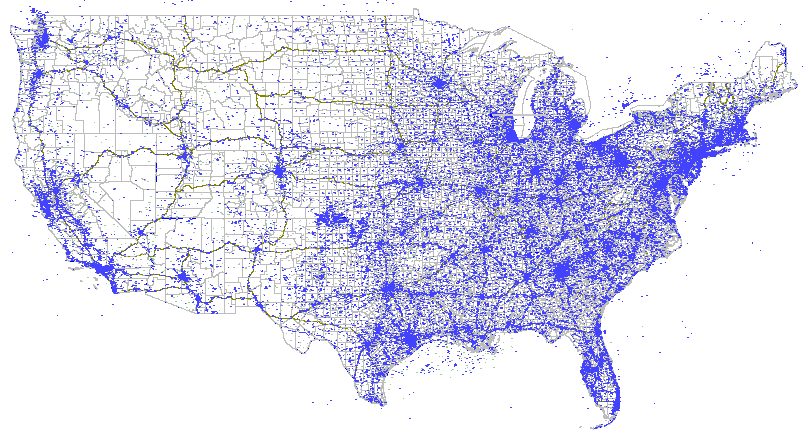Teaching:TUW - UE InfoVis WS 2007/08 - Gruppe 06 - Aufgabe 1 - Thematic Map
Defintion[edit]
For example:
- Physical phenomena like climate
- Human characteristics
- Population density
- Health issues like cholera
- Economy
- Traffic
History & Development[edit]


The term 'thematic map' was introduced first by the german Nikolaus Kreutzburg on a cartography meeting in 1952. Before that, people used other, non-correct terms for these maps.
The 'Nubian Goldmine' map (ancient world ) could already be labeld as a thematic map, however in a sense thematic maps existed since the 16th/17th century. For Example, Edmond Halley (1686) created a map, which included the information of the direction of trade winds in the Atlantic Ocean.
Another famous example of an early thematic map was created by John Snow in 1855 and specifies the cholera progression in a specific area.
Use of Thematic Maps[edit]
Important aims of Thematic Maps:
- Thematic Maps provide specific information about particular locations
- They include general information of spatial patterns
- They open the possibility to compare patterns on one or two different maps
Further it is important for the cartographers to be careful to portray the data on the map so that it will be easy for the audience to use and understand. But they have even to notice the spatial accuracy, the aesthetics, human visual perception, the presentation format and the audience. The audience is very important because a political scientist will have other interest than a biologist scientist.
Even the marks and symbols a cartographer uses to represent data are relevant. Next step for displaying data is to collect data sets. Therefore you have to differ between univariate, bivariate and multivariate mapping.
Univariate mapping means to deal with one subject like cancer rates or the rainfall of a year. In comparison the bivariate mapping deals with two subjects like the population density in relation to the textile manufacturing. Multivariate mapping means only to deal with more than two subjects.
In following domains for example, thematic maps are used: administation, scheduling, environment, education, science, public relations, transport & tourismn, documentation, national defense, or mass media.
Methods[edit]





The most important methods for designing a thematic map are:
- Choropleth
- Proportional Symbol
- Isolines
- Dot
- Dasymetric
Choropleth[edit]
Choropleth maps are the most common thematic maps. A choropleth map displays statistical data, which is colored or patterned accordingly to their distribution. Therefor it is necessary to collect the data of equal areas which are as small as possible. Like a grid with e.g. 1km² elements.
This provides an easy way to demonstrate how data is shared across a geographic area, e.g. population density. Typically they are used after elections to show the spreading of the votes. (In these examples administrative borders are used instead of raster variants)
Proportional Symbol[edit]
Proportional Symbols maps represent data associated with point locations. Interpretations of statistics represented by these maps are simple to understand. The Proportional Symbols vary in size from place to place on a map in proportion to the quantities they represents.
Isolines[edit]
An Isoline map uses contour lines to join points where a function has a same particular value and thus show valleys and hills, and the steepness of slopes. Contour lines are curved or straight lines on a map describing the intersection of a real or hypothetical surface with one or more horizontal planes.
Dot[edit]
These maps use dots to show the presence of a feature or occurrence and display a spatial pattern. A dot is not necessarily required to represent a single unit and may indicate any number of entities.
Dasymetric[edit]
Dasymetric maps utilize areal symbols to spatially classify volumetric data. However, although boundaries are displayed on dasymetric maps, these geographic units may span multiple theme values.
References[edit]
[Ross] Zev Ross, ZevRoss Spatial Analysis. Retrieved at: November 8, 2007. http://www.zevross.com/special/history/halley.gif.
[Answers.com] John Snow. Retrieved at: November 8, 2007. http://www.answers.com/topic/john-snow-physician
[bbc.co.uk] BBC – Education Scotland – Standard Grade Bitesize. Retrieved at: November 8, 2007. http://www.bbc.co.uk/scotland/education/bitesize/standard/geography/population/distribution_density_rev3.shtml
[forums.nbn.org.uk] Joint Nature Conservation Committee. Retrieved at: November 8, 2007. http://forums.nbn.org.uk/recreport/index.php?id=5
[www.volcano.si.edu] Global Volcanism Program. Retrieved at: November 8, 2007. http://www.volcano.si.edu/world/volcano.cfm?vnum=0804-04=&volpage=var
[Dodge] Martin Dodge, An Atlas of Cyberspaces. Retrieved at: November 8, 2007.
http://www.cybergeography.org/atlas/tower_maps_large.gif
[www.usgs.gov] Population Density of the San Francisco Bay Area. Retrieved at: November 8, 2007.
http://geography.wr.usgs.gov/science/dasymetric/images/zoom2_lowres.jpg
[en.wikipdedia.org] Thematic map. Retrieved at: November 8, 2007. http://en.wikipedia.org/wiki/Thematic_map
[Dr. Michael P. Peterson] THEMATIC MAPS. University of Nebraska at Omaha. Retrieved at: November 8, 2007. http://maps.unomaha.edu/Peterson/carta/Notes/THEMMAP.html
[www.gigawiz.com] Thematic Maps and Map Projection Utilities. Retrieved at: November 8, 2007. http://www.gigawiz.com/thematic.html
[Jeffrey J Hemphill] Proportional Symbol Maps with ArcGIS. Retrieved at: November 8, 2007. http://www.geog.ucsb.edu/~jeff/gis/proportional_symbols.html
[Scott Freundschuh] Course Map Design. UNIVERSITY OF MINNESOTA DULUTH. Retrieved at: November 8, 2007.http://www.d.umn.edu/geog/cartfolder/HTML%20Pages/Map-Types.htm
[Michelle Halsell] Nubian Gold. Education Development Center, Inc. Retrieved at: December 2,2007. http://www.dignubia.org/maps/timeline/bce-1450.htm